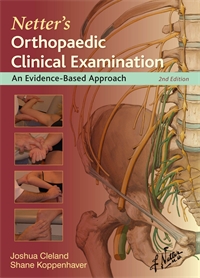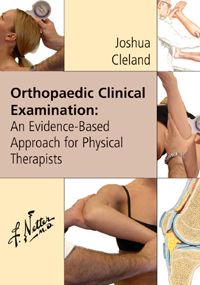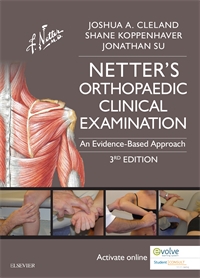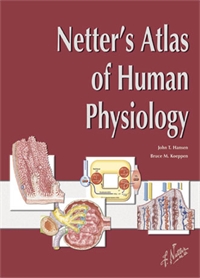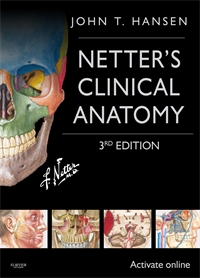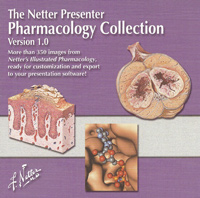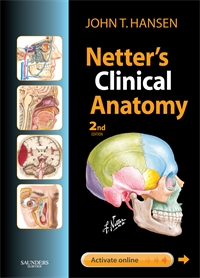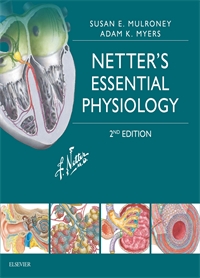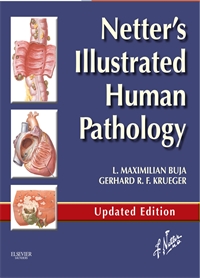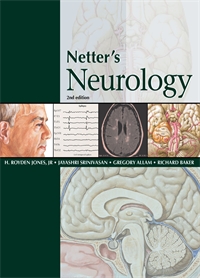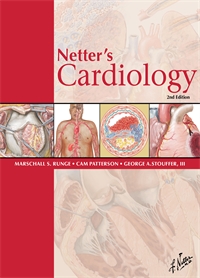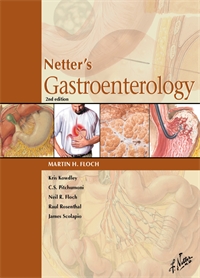Orthopaedic Clinical Examination - Cleland 2E
An Evidence-Based Approach
Author: Joshua A. Cleland, PT, PhD, and Shane Koppenhaver, PT, PhD
ISBN: 9781437713848
- Page 5: Sensitivity and Specificity Example
- Page 5: 100% Sensitivity
- Page 6: Orthopaedic Clinical Examination: 100% Specificity
- Page 8: Fagan's Nomogram
- Page 9: Nomogram Representing the Change In Pretest Probability
- Page 10: Probability and Likelihood Ratios
- Page 17: Skull and Neck
- Page 18: Skull: Mandible
- Page 19: Skull: Lateral View
- Page 20: Temporomandibular Joint
- Page 20: Temporomandibular Joint Mechanics
- Page 21: Temporomandibular Joint Ligaments
- Page 22: Muscles Involved In Mastication
- Page 23: Muscles Involved in Mastication
- Page 24: Floor of Mouth: Lateral, Slightly Inferior View
- Page 25: Floor of Mouth
- Page 26: Mandibular Nerve (V3)
- Page 27: The Association of Oral Habits With Temporomandibular Disorders
- Page 28: Temporomandibular Joint Pain
- Page 32: Detecting Anterior Disc Displacement of the Temporomandibular Joint
- Page 32: Accuracy of Clinical Criteria for Classifying Internal Derangement and Arthrosis
- Page 35: Diagnostic Criteria for Detecting Intra-articular Temporomandibular Disorders
- Page 36: Palpation Tests
- Page 40: Detecting Osteoarthrosis In the Temporomandibular Joint
- Page 42: Range-of-Motion Measurements of the Temporomandibular Joint
- Page 44: Joint Play and End-Feel Assessment of the Temporomandibular Joint (TMJ)
- Page 47: Assessment of Pain During Passive Opening
- Page 48: Identifying Patients With Craniomandibular Pain
- Page 49: Temporomandibular Traction
- Page 51: Manual Resistance Applied During Mouth Opening and Closing
- Page 52: Bilateral Temporomandibular Compression
- Page 54: Accuracy of Combined Tests for Detecting Anterior Disc Displacement With Reduction
- Page 56: Combined Tests for Detecting Anterior Disc Displacement Without Reduction
- Page 58: Occlusal Stabilization Splint
- Page 67: Bony Framework of Head and Neck
- Page 68: Cervical Spine
- Page 69: Joints of the Cervical Spine
- Page 70: Internal Craniocervical Ligaments
- Page 71: External Craniocervical Ligaments
- Page 72: Muscles of Neck: Anterior View
- Page 73: Extrinsic Muscles of the Larynx and Their Action Infrahyoid and Suprahyoid Muscles
- Page 75: Scalene and Prevertebral Muscles
- Page 77: Suboccipital Triangle
- Page 79: Brachial Plexus: Schema
- Page 80: Cervical Zygapophyseal Pain Syndromes
- Page 81: Pain Referral Patterns
- Page 83: Cervical Radiculopathy
- Page 85: Dermal Segmentation of Upper Limb
- Page 87: Manual Muscle Testing of the Upper Limb
- Page 89: Cervical Radiculopathy: Muscle Stretch Reflexes
- Page 90: Compression Fractures of Cervical Spine
- Page 94: Range of Motion
- Page 98: Overpressure Testing
- Page 99: Cervical Flexor Endurance
- Page 100: Assessing Limited Passive Intervertebral Motion
- Page 102: Testing Side Bending of C5-C6
- Page 103: Posteroanterior Central Glides to the Mid Cervical Spine
- Page 106: Scheuermann's Disease
- Page 107: Muscle Length Assessment
- Page 108: Cervical Compression Test
- Page 109: Spurling's Test
- Page 110: Neck Distraction and Traction Tests
- Page 111: Shoulder Abduction Test
- Page 113: Upper Limb Tension Tests
- Page 115: Sharp-Purser Test
- Page 116: Cervical Disc Herniation
- Page 117: Fagan's Nomogram
- Page 119: Cervical Manipulation
- Page 121: Thoracic Spine Manipulation and Active Range of Motion
- Page 124: Cervical Traction
- Page 133: Thoracic Vertebrae
- Page 133: Lumbar Vertebrae
- Page 134: Thoracic Vertebrae
- Page 134: Ribs and Sternocostal Joints
- Page 135: Joints of the Thoracic Spine
- Page 136: Joints of the Lumbar Spine
- Page 137: Costovertebral Joints
- Page 138: Vertebral Ligaments: Lumbar Region Ligaments of the Spinal Column
- Page 140: Muscles of Back: Superficial Layers Superficial Muscles: Posterior Neck and Back
- Page 141: Muscles of Back: Intermediate Layers Spenius and Erector Spinae Muscles
- Page 142: Muscles of Back: Deep Layers Transversospinal, Interspinal, Intertransverse, and Suboccipital Muscles Deep Muscles: Posterior Neck and Back
- Page 143: Muscles of Anterior Abdominal Wall
- Page 144: Thoracolumbar Fascia
- Page 145: Thoracoabdominal Nerves Course of Typical Thoracic Nerve Innervation of Abdomen and of Perineum
- Page 146: Lumbar Plexus Nerves: Lumbar Plexus
- Page 148: Innervation of Abdomen and of Perineum Lumbosacral and Coccygeal Plexuses
- Page 150: Lumbar Zygapophyseal Joint Pain Referral Patterns
- Page 151: Zygapophyseal Pain Patterns of the Thoracic Spine
- Page 155: Ankylosing Spondylitis
- Page 157: Herniated Nucleus Pulposus (Lumbar); Clinical Features
- Page 158: Lumbar Spinal Stenosis Testing
- Page 160: Range of Motion Measurement
- Page 161: Pain Provocation During Active Movements
- Page 162: Modified Biering-Sorensen
- Page 164: Accentuated Spinal Curvatures
- Page 167: Assessment of Posteroanterior Segmental Mobility
- Page 168: Segmental Mobility Examination
- Page 170: Prevalence Rates of "Fixations" Detected During Motion Palpation
- Page 171: Assessing Lumbar Passive Physiological Intervertebral Motion (PPIVM)
- Page 174: Centralization Phenomena
- Page 175: Straight-Leg Raise
- Page 178: Slump Test
- Page 179: Role of Inflammation In Lumbar Pain
- Page 181: Prone Instability Test
- Page 183: Degenerative Disc Disease
- Page 185: Nomogram Representing the Posttest Probability of Lumbar Instability
- Page 190: Indentifying Patients Likely to Benefit From Spinal Manipulation
- Page 201: Bony Framework of Abdomen Bony Framework of Abdominopelvic Cavity Landmarks and Other Structures
- Page 202: Sacrum and Coccyx Osteology
- Page 203: Coxal Bone
- Page 204: Sex Differences of Pelvis: Measurements
- Page 205: Sacroiliac Joint
- Page 206: Bones and Ligaments of Pelvis
- Page 207: Sacroiliac Region Muscles
- Page 209: Sacral and Coccygeal Plexuses
- Page 210: Sacroiliac Dysfunction
- Page 212: Sacroiliac Joint Pain Referral Patterns
- Page 212: Sacroiliac Joint Pain Referral Patterns
- Page 215: Assessment of Iliac Crest Symmetry In Standing
- Page 221: Patrick Test
- Page 221: Thigh Thrust
- Page 221: Compression Test
- Page 222: Sacral Thrust Test
- Page 222: Gaenslen Test
- Page 223: Distraction Test
- Page 224: Mennell's Test
- Page 225: Resisted Abduction of the Hip
- Page 227: Gillet Test
- Page 228: Spring Test (Joint Play Assessment)
- Page 229: Long-Sit Test (Supine to Sit Test)
- Page 230: Standing Flexion Test
- Page 231: Sitting Flexion Test
- Page 232: Prone Knee Bend Test
- Page 234: Sacroiliac Pain Provocation Test
- Page 235: Cluster of Tests for Sacroiliac Dysfunction After the McKenzie Evaluation to Rule Out Discogenic Pain
- Page 236: Indentifying Patients Likely to Benefit From Spinal Manipulation
- Page 237: Nomogram for Bayes' Theorem
- Page 245: Coxal Bone
- Page 245: Femur: Lines of Attachment and Reflection of Synovial Membrane and Fibrous Capsule
- Page 246: Hip and Pelvis Joints
- Page 247: Hip Joint
- Page 249: Muscles of Back of Hip and Thigh Muscles of Hip and Thigh: Posterior Views
- Page 251: Muscles of Front of Hip and Thigh
- Page 252: Nerves of Buttock
- Page 253: Arteries and Nerves of Thigh: Deep Dissection (anterior view)Arteries and Nerves of Thigh: Anterior Views
- Page 256: Measurement of Passive Range of Motion
- Page 259: Hip Joint Involvement in Osteoarthritis
- Page 261: Passive Range of Motion Measurement
- Page 262: Osteonecrosis After Fracture
- Page 263: Detecting Developmental Dysplasia of the Hip In Infants: Limited Hip
- Page 267: Detecting Osteoarthritis of the Hip: The Cyriax Capsular Pattern
- Page 268: Tests for Iliotibial Band Length
- Page 269: Thomas Test
- Page 271: Measurement of Muscle Length With a Bubble Inclinometer
- Page 275: Detecting Acetabular Labral Tears: Internal Rotation - Flexion - Axial Compression Maneuver
- Page 276: Percussion Test
- Page 277: Thigh and Hip Trauma
- Page 285: Femur
- Page 285: Tibia and Fibula
- Page 286: Sagittal Knee
- Page 287: Posterior Ligaments of Knee
- Page 288: Interior and Anterior Ligaments of Knee
- Page 289: Anterior Muscles of Knee
- Page 291: Knee: Lateral and Medial Views
- Page 292: Obturator Nerve
- Page 293: Femoral Nerve and Lateral Femoral Cutaneous Nerves
- Page 294: Sciatic Nerve (L4, L5; S1, S2, S3) and Posterior Femoral Cutaneous Nerve (S1, S2, S3) Sciatic Nerve and Posterior Cutaneous Nerve of Thigh
- Page 295: Rupture of the Anterior Cruciate Ligament
- Page 296: Joint Pathology In Osteoarthritis
- Page 297: Sprains of Knee Ligaments
- Page 298: Identifying the Need to Order Radiographs Following Acute Knee Trauma
- Page 299: Nomogram for Bayes' Theorem
- Page 300: Detecting Cardinal Signs of Inflammation of Knee: Fluctuation Test
- Page 301: Measurement of Active Knee Flexion Range of Motion
- Page 302: Assessment of End-Feel for Knee Flexion
- Page 305: Quadriceps Length
- Page 306: Examination of Mediolateral Patellar Tilt
- Page 307: Examination of Mediolateral Patellar Orientation
- Page 308: Examination of Anterior Or Posterior Patellar Tilt
- Page 309: Examination of Patellar Rotation
- Page 310: Quadriceps Angle Measurements
- Page 311: Patella
- Page 312: Palpation of Joint Lines
- Page 313: Testing Integrity of Anterior Cruciate Ligament Using Lachman Test
- Page 314: Detecting Anterior Cruciate Ligament Ruptures: The Anterior Drawer Test
- Page 315: Pivot Shift Test
- Page 316: Valgus and Varus Stress Tests
- Page 317: McMurray's Test
- Page 318: Diagnosing a Meniscal Lesion: Apley Grinding Test
- Page 319: Ege's Test
- Page 320: Thessaly Test
- Page 321: Moving Patellar Apprehension Test
- Page 323: Tears of Meniscus
- Page 325: Nomogram for Bayes' Theorem
- Page 326: Hip Mobilization Technique Used In the Management of Patients With Knee Osteoarthritis
- Page 337: Bones of Foot
- Page 338: Bones of Foot
- Page 339: Talocrural (Hinge) Joint
- Page 340: Posterior Ankle
- Page 341: Lateral Ligaments of Ankle
- Page 342: Medial Ligaments of Ankle
- Page 343: Capsules and Ligaments of Metatarsophalangeal and Interphalangeal Joints
- Page 344: Tendon Insertions and Ligaments of Sole of Foot
- Page 346: Muscles of Leg: Lateral View
- Page 347: Muscles, Arteries, and Nerves of Leg: Deep Dissection (posterior view) Muscles of Leg (Deep Dissection): Posterior View Muscles: Deep Posterior Compartment
- Page 348: Muscles, Arteries, and Nerves of Front of Ankle and Dorsum of Foot: Deeper Dissection Dorsum of Foot: Deep Dissection
- Page 349: Muscles of Sole of Foot: First Layer
- Page 350: Muscles of Sole of Foot: Second Layer
- Page 351: Muscles of Sole of Foot: Third Layer
- Page 352: Interosseous Muscles and Plantar Arterial Arch Interosseous Muscles and Deep Arteries of Foot
- Page 353: Common Peroneal Nerve (L4, L5; S1, S2) Common Fibular (Peroneal) Nerve
- Page 354: Tibial Nerve (L4, L5; S1, S2, S3)
- Page 357: Detecting Ligamentous Injuries: Tibiofibular Syndesmosis (Squeeze Test)
- Page 357: Proprioceptive Measures: Dorsiflexion / Compression Test
- Page 357: Ottawa Ankle Rules
- Page 358: Nomogram for Bayes' Theorem
- Page 360: Lunge Measurements
- Page 360: Measurements of Relaxed Calcaneal Stance Position
- Page 361: Diagnostic Utility of the Paper Grip Test for Detecting Toe Plantarflexion Strength Deficits
- Page 362: Measurement of Navicular Height
- Page 363: Assessment of Medial Arch Height: Measurement of Arch Angle
- Page 364: Measuring Forefoot Position: Determination of Forefoot Varus and Valgus
- Page 366: Single Leg Hop Test
- Page 367: Accuracy of the Functional Hallux Limitus Test to Predict Abnormal Excessive Midtarsal Function During Gait
- Page 368: Figure-of-Eight Measurement
- Page 369: The Feet In Rheumatoid Arthritis
- Page 370: Impingement Sign
- Page 371: Windlass Test
- Page 372: Anterior Drawer Sign of Ankle for Test of Talofibular Ligaments
- Page 379: Scapula and Humerus
- Page 379: Shoulder: Bones (Pectoral Girdle)
- Page 380: Sternoclavicular Joint
- Page 381: Scapulohumeral Rhythm
- Page 382: Shoulder Ligaments: Anterior View
- Page 383: Shoulder (Glenohumeral) Joint
- Page 384: Shoulder: Muscles
- Page 385: Shoulder: Muscles
- Page 386: Muscles of Rotator Cuff
- Page 388: Axilla (Dissection): Anterior View Shoulder and Axilla: Deep Dissection
- Page 390: Range of Motion Measurements
- Page 391: Measuring Internal Rotation: Hand Behind Back Method
- Page 393: Measuring Pectoralis Minor Muscle Strength
- Page 394: Rotator Cuff Tears (Unspecified Muscles)
- Page 396: Detecting Scapular Asymmetry
- Page 397: Adhesive Capsulitis of Shoulder (Frozen Shoulder)
- Page 398: Shoulder Instability
- Page 399: Apprehension Test
- Page 400: Relocation Test
- Page 401: Anterior Drawer Test
- Page 402: Detecting Labral Tears: Crank Test
- Page 404: Compression Rotation Test
- Page 405: Detecting Biceps Tendon Lesions: Speed Test
- Page 406: Active Compression Test
- Page 408: Yergason Test
- Page 409: Detecting Labral Tears: Anterior Slide Test
- Page 410: Kim and Jerk Tests
- Page 413: Detecting Subacromial Impingement: Hawkins and Kennedy Test
- Page 414: Detecting Subacromial Impingement: Neer Test
- Page 416: Detecting Subacromial Impingement: Horizontal Adduction Test
- Page 416: Detecting Subacromial Impingement: Yocum Test
- Page 417: Internal Rotation Resistance Strength Test
- Page 418: Detecting Rotator Cuff Tears: Historical Examination
- Page 418: Supraspinatus Tear: Empty Can
- Page 419: Hornblower's Sign
- Page 424: Lift-Off-Test
- Page 425: Brachial Plexus: Schema
- Page 426: Detecting Acromioclavicular Lesions
- Page 441: Bones of Elbow
- Page 442: Anterior and Posterior Opened Eblow Joint
- Page 443: Ligaments of Elbow
- Page 444: Forearm: Bones
- Page 445: Muscles of Forearm (Deep Layer): Posterior View
- Page 446: Muscles of Forearm (Intermediate Layer): Anterior View
- Page 447: Individual Muscles of Forearm: Rotators of Radius
- Page 448: Arteries, Nerves, and Muscles of Upper Limb (Anterior View) Muscles of Forearm (Deep Layer): Anterior View
- Page 449: Epicondylitis
- Page 450: Range-of-Motion Measurements: Elbow Flexion and Extension
- Page 451: Forearm Supination and Pronation Measurements
- Page 452: End-Feel for Elbow Flexion and Extension Assessment
- Page 454: Detecting Cubital Tunnel Syndrome: Tinel Sign
- Page 455: Detecting Medial Collateral Tears
- Page 463: Carpal Bones Osteology of the Wrist The Carpal Bones
- Page 464: Bones of Wrist and Hand
- Page 465: Wrist Joint
- Page 467: Ligaments of Volar Aspect of Wrist with Transverse Carpal Ligament Removed Ligaments of Wrist Joints: Wrist
- Page 468: Posterior Ligaments of Wrist
- Page 469: Metacarpophalangeal and Interphalangeal Ligaments Metacarpophalangeal and Interphalangeal Joints
- Page 470: Individual Muscles of Forearm: Extensors of Wrist and Digits
- Page 471: Individual Muscles of Forearm: Flexors of Wrist
- Page 472: Individual Muscles of Forearm: Flexors of Digits
- Page 473: Intrinsic Muscles of Hand
- Page 474: Intrinsic Muscles of Hand
- Page 475: Median Nerve
- Page 476: Ulnar Nerve
- Page 477: Radial Nerve in Forearm
- Page 480: Carpal Tunnel Syndrome
- Page 482: Testing for Tenderness of Anatomical Snuff Box
- Page 483: Acute Pediatric Wrist Fractures: Clinical Prediction Rule
- Page 484: Range-of-Motion Measurements of Wrist: Flexion
- Page 485: Wrist Range of Motion
- Page 486: Range-of-Motion Measurements of Fingers: Proximal Interphalangeal Joint Flexion
- Page 487: Hand-Held Dynamometry: Measurement of Grip Strength
- Page 488: Measurement of Pinch Strength
- Page 491: Figure-of-Eight Measurement
- Page 493: Testing Sensation
- Page 494: Carpal Tunnel Syndrome: Tinel Sign
- Page 496: Phalen's Test
- Page 498: Carpal Tunnel Syndrome: Carpal Compression Test
- Page 499: Upper Limb Tension Test A
- Page 500: Detecting Carpal Instability
- Page 501: Ulnar Fovea Sign
- Page 502: Nomogram for Bayes' Theorem
